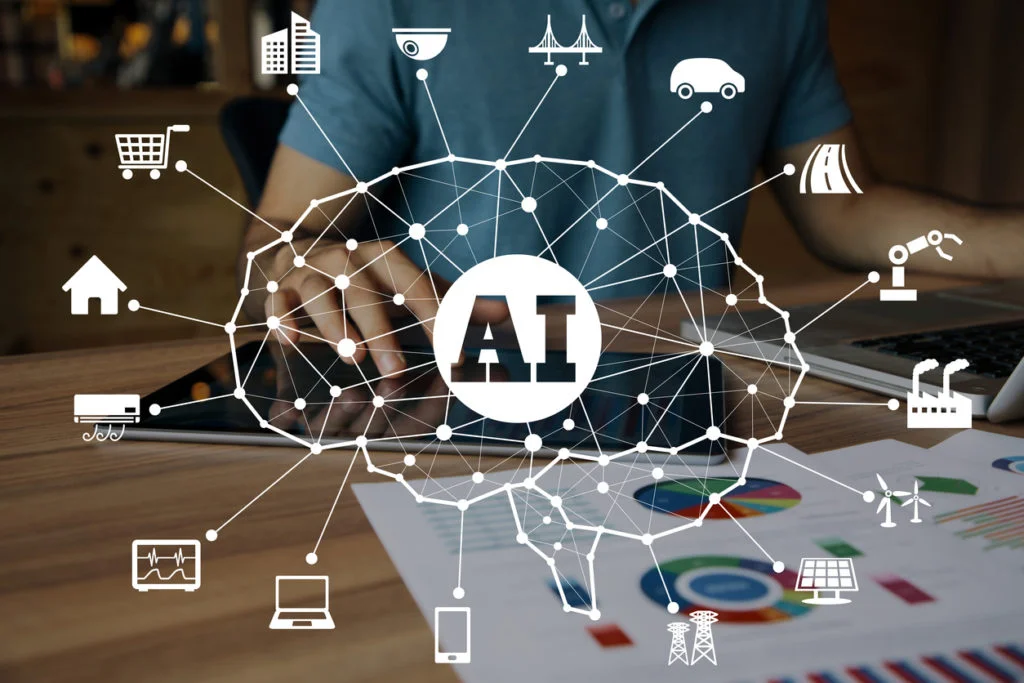This post is the second entry in our series on AI application patterns across multiple industries.
In the previous post, we discussed the evolution of AI chatbots, speech recognition, and sentiment analysis technology over the years, and how it is helping to transform words and communication logic into intelligent business assistants.
In this post, we will discuss how AI-based computer vision technology, such as Face Recognition, Body Measurement, Object Recognition, etc. is being utilized to solve complex business problems. More specifically, we will be investigating how AI recognition technology is helping turn images, objects, and people into business intelligence.
What is Computer Vision Technology?
A field of science, computer vision is what enables computers to capture, process, interpret, and understand visually perceivable objects. Additionally, AI and deep learning models allow computer vision systems to make sense of the captured images and respond in an appropriate way.
Today, businesses across a wide range of industries are using and benefiting from computer vision technology. From identification to quality control to on-site and predictive, there are plenty of benefits of using computer vision technology for businesses.
Computer vision is the technology that enables AI systems to ‘see’ the way humans do. Interest in the technology has increased over the years. Additionally, rigorous research in the field has led to the evolution of this technology during different decades.
For example, some of the first neural networks were utilized in the 1950s to separate simple objects into categories such as squares and circles. These were the first experiments to take place in computer vision.
Fast forward two decades, and we saw the commercial use of computer vision handwritten text that used optical character recognition for the very first time. The purpose of this development was to interpret written text for the visually impaired.
With the internet becoming more widespread and mature in the 1990s, the world witnessed large image sets being made available for analysis. This helped facial recognition programs to enter the limelight and flourish. As these data sets grew, it became easier for machines to detect specific people in images and videos. Today, several factors have combined to bring about a revolution in computer vision. These include:
- Mobile technology with a built-in camera
- More affordable and easily accessible computing power
- More widely available hardware designed for computer vision and analysis
- Algorithms like convolutional neural networks (CNNs) that can make optimal use of hardware and software capabilities
How Computer Vision Works
Although they are often used interchangeably, computer vision and image recognition are not the same things. While image recognition is all about looking at images and identification, computer vision helps to achieve a lot more.
There are many areas in which computer vision not only matches, but also surpasses the visual abilities of humans. These include (but are not limited to) processing live events and recognizing faces and objects. If you’re wondering how the computer vision technology works, then below are the three basic steps enabling computer vision.
1. Acquiring an Image
Using photos, video, or three-dimensional (3D) technology, computer vision acquires images, sometimes in very large sets, in real-time for analysis.
2. Processing the Image
A good part of this process is automated by deep learning models. However, most of the time, thousands of pre-identified or labeled images are fed to the models first to train them.
3. Understanding the Image
The final step involves computer vision understanding or making sense of the image or object under investigation. An interpretive step, this is where the image/object is identified or classified.
These are the basic steps involved in the working of computer vision technology. However, computer vision can be taken a step further using AI systems to perform actions that are based on the technology’s interpretation/ understanding of the image/object.
The Different Types of Computer Vision
As mentioned above, AI systems can be leveraged to perform actions using computer vision that are based on the technology’s interpretation/ understanding of the image/object. These actions are the different types of computer vision being used today. Some of these actions or types of computer vision are listed below.
1. Facial Recognition
A sophisticated technology that detects objects, facial recognition can not recognize a human face in an image, but it can also pinpoint a specific individual.
2. Image Segmentation
This process involves the partitioning or categorization of images onto multiple pieces or regions so that they can be investigated separately.
3. Object Detection
The process that defines objects in an image, object detection is used to identify a specific object in an image. The object is labeled, and the bounding boxes are outputted. Within a single image, several objects can be identified by advanced object detection.
For instance, in a single image of a football game, it can detect objects such as a ball, an offensive player, a defensive player, a football field, and more. A bounding box is created using an X, Y coordinate by these models, and then everything inside the box is identified.
4. Gesture Detection
Gesture detection is a promising Human-Machine Interaction (HMI) technology that uses mathematical algorithms to interpret human gestures. This perceptual user interface (PUI) component allows computers to capture and make sense of human gestures as commands. Today, gesture detection is being employed for a variety of purposes, including interpreting sign language.
5. Pattern Detection
A process that looks to recognize visual indicators in images, pattern detection is used to recognized repeated colors, shapes, and more in an image.
6. Image Classification
This is a type of computer vision that separates images into different categories. A popular computer vision technique, image classification segments images into appropriate categories by using computer vision algorithms. A data-driven process, image classification is an extremely interesting and informative type of computer vision.
7. Feature Matching
A type of computer vision that involves pattern detection, features classifies images by matching the similarities in them.
8. Object Tracking
A type of computer vision that tracks moving objects in a given scene, object tracking is typically used in the real world to track interactions after the detection of the initial object. Uber and Tesla have plans to release this aspect of computer vision in their self-driving cars soon, which shows the importance of object tracking today.
There are two categories into which object tracking can be separated—generative and discriminative. The former is used to explain the underlying characteristics, minimize reconstruction error, and search for the subject. The discriminative approach, on the other hand, is comparatively more accurate and powerful; it can be used to differentiate between the background and the subject.
9. Image Reconstruction
The final type of computer vision on our list is image reconstruction. With image reconstruction, an old but valuable image that has been damaged over the years can be restored to its original form or at least close to it. In other words, image reconstruction can be used to repair corrupted versions of an image. For many people, this is a dream come true.
The Current Applications of Computer Vision Technology
Now that you know about the different types of computer vision, you are ready to find out where computer vision technology is currently being employed. Below are some of the current applications of computer vision technology.
1. Facial Recognition and Biometrics
For security purposes, computer vision technology, like facial recognition and biometrics, are employed to identify individuals. Securing smartphones is the most common example of facial recognition or biometrics being used for security purposes.
Security systems in residential or business facilities that verify the identity of individuals through unique physiological features are examples of advanced or sophisticated forms of facial recognition and biometrics technology.
The unique patterns in the fingerprints of an individual can be identified with deep learning and then used to control access to bank vaults, research labs, nuclear powerplants, and other high-security areas. In addition to this, the subtle differences in the patterns in the Irises and Retinas of people can be recognized by the computer vision system. This can help enhance the security of high-value locations and assets.
For example, a security solutions company with a focus on the events industry enhanced security and surveillance at events using powerful facial-recognition technology developed by Achievion.
2. Self-Driving Vehicles
Self-driving cars should be able to identify other vehicles, sign-posts, obstacles, and any person in their way to navigate through the streets safely. Ultrasonic sensors and LiDAR are present in self-driving cars to ensure this. Additionally, the cars safely navigate the streets by using cameras that provide computer vision and cover their entire perimeter.
Through the implementation of computer vision technology, self-driving vehicles are able to follow traffic rules and interpret road signs; this helps to maximize their safety on the road. Moreover, the technology enables vehicles to make important decisions on the road, such as giving way to fire engines and ambulances.
3. Medical Diagnosis
Another area where computer vision technology is being utilized today is in the identification of patterns that the human visual system may miss. An example of this is the development of an artificial intelligence (AI) system that utilizes computer vision to detect cancer tumors; the AI system detects the tumors by looking at CT scan images.
The idea is to be able to perform a better diagnosis of lung cancer than human radiologists. This is because computer vision can detect diseases with greater accuracy than humans. By ensuring early and accurate detection of cancer, the AI system using computer vision will allow patients to receive timely treatment.
4. Law and Order
Vital information can be made available to law and security officials by using computer vision to scan recorded or live surveillance footage. An example of this would be the identification of dangerous objects such as guns by using computer vision to scan the live footage from a public area; it can also be used to detect movement or behavioral patterns that seem suspicious.
5. Manufacturing
While IoT is helping to revolutionize manufacturing by ensuring greater autonomy for different industrial processes, other technologies are needed to bring other improvements in the sector. Computer vision is one such technology. With computer vision, it will be easier to detect non-conformities and defects in manufactured products. This, in turn, will eliminate the need for human workers to carry out inspections on the production line.
6. Customer Experience (CX)
Computer vision is being employed today to offer ‘unique’ experiences. Examples of this include platforms such as Animoji and Snapchat. The purpose of using computer vision in CX is to provide consumers with an intuitive, appealing, and entertaining product which they would want to return to repeatedly. If used strategically, this can bring several benefits to any business.
The Future of Computer Vision Technology
In the future, computer vision will have far more applications than it has today. This will happen as a result of the research on and improvement/evolution of the technology. It will also become easier to train computer vision technologies in the future, and they will be able to extract more insights from images than currently.
In addition to the above, it will be possible to use computer vision with other AI subsets in the future to come up with extremely effective applications. An example of this is the combination of natural language generation (NLG) with applications for image captioning to decipher the objects within the surroundings for visually challenged people.
Finally, computer vision will provide artificial general intelligence (AGI) and artificial superintelligence (ASI) systems with a better ability than humans to process information to help aid their development. This will benefit a wide range of industries.
Final Word
Like any other advanced technology today, computer vision has both pros and cons. However, the advantages of computer vision far outweigh the disadvantages of this technology. With computer vision becoming increasingly prevalent, it is only a matter of time before we see large scale investments in the research and development (R&D) in the field that helps it achieve the future that it is destined for.
Achievion team helped turn images, objects, and hand-written text into business intelligence to a number of companies by designing, developing and training intelligent AI-powered computer vision solutions. Reach out to us if your organization wants to leverage this technology as well.
In the next article in this series, we will look at how predictive analytics and decision support technology can be used to create intelligent predictive models.









